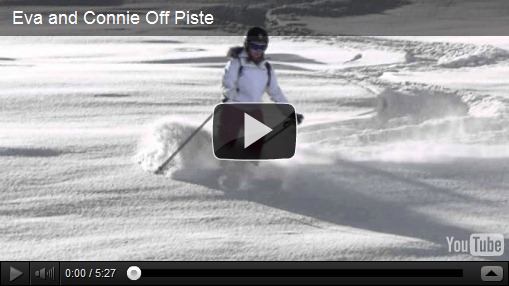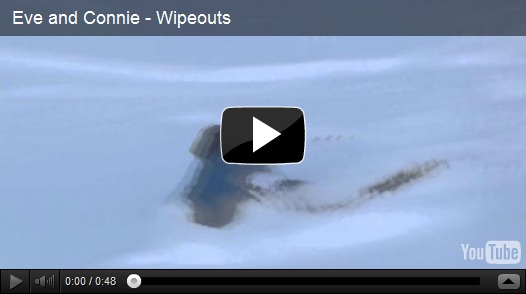Dee seemed very positive this morning and was very happy to have both lost the snowplough and to be laying previous “skiing traumas” to rest. We started off with the jumping again just to get things going, but soon stopped that to replace it with just dynamics and active leg coordination.
During the jumping the left leg to brain connection had some interference again – but this was improved with a bit of work. I asked Dee to try to use support from the downhill pole and to jump towards it – into the turn. When the jumping was removed the centre of mass would have to be displaced in this direction – because everything is controlled by the motion of the centre of mass. Dee managed this well and there was steady progress. Before removing the jumping I reminded Dee to roll her foot (outside leg) and pull inwards with the adductors so as to provide a strong base of support for the dynamics. Dee was progressively able to overcome her tendency to “push out” (stem) the outside ski, and work towards pulling it inwards. With skiing being “holistic” it is remarkably tolerant of inaccurate movements so Dee had to use her own feedback to know when she was getting it right. (plus my shouting!) When skiing parallel at the end Dee sensed for herself that she was moving her shoulders instead of her centre of mass (between the pelvis and the navel). Eve and Connie were desperate for a day off-piste and as luck would have it there was fresh snow overnight and a cold front with sunshine forecast for later in the day. We started off with a short lesson on how to use transceivers as they would both be equipped with analogue transceivers. I prefer old analogue to digital technology because the signal range is much further and there is no on-board software that can go wrong. In 35 years of skiing I’ve never had to use one in an emergency and consider that good decision making is the real key to survival – but I can say the same for my car seat belt, so I never go off-piste without one. Pole straps were not being used – so that poles can be jettisoned in the event of an avalanche and the hands kept free to protect the face. I’d shown the girls a few days ago that I never use straps and they are not necessary – so they hadn’t bothered with theirs since anyway. We were not going near any big steep slopes today.
We went straight into the fresh snow from the top of the first lift and I didn’t say anything. It was time for the hard work of the previous three days to be put to the test. Eve skied like a dream straight off and Connie was in heaven on the gentle gradients and fresh snow – despite it being only her 10th ever day on skis. I knew it would get much tougher for her as we gradually increased the gradient due to her mixture of a wide stance and rotation. Most people when confronted with this issue off-piste just seize up totally but Connie fought back to make it work and gradually narrowed and lowered her stance to help overcome the rotation. By the end of the day she was negotiating very steep slopes without falling and had a nice rhythm and feel for the skis and snow developing on the gentler terrain. The lower seated stance places the knees and feet ahead and when facing downhill in fall-line pivoting it shifts the centre of mass further back, without stiffening the legs or leaning on the boots and keeping the resultant forces passing through the feet. (Think of sitting on a chair facing downhill on a steep slope – with the chair at the same angle as the slope). The flexed legs help to combat rigidity and hence rotation, plus this facilitates keeping the hip inside the turn. The narrow stance, with adductors in both legs pulling inwards, prevents the outside ski from sinking too far and pulling the skier over. A wide stance does also work – but not when there is stiffness and rotation.
Eve was remarkably responsive to the resonance of the skis and used the bouncing very well, which, combined with the dynamics and pivoting meant that she could handle almost anything straight off. Even watching her playing with “skating” timing back on the piste it was clear that she was beginning to connect with that too – thanks to the trampoline-like bounce of the skis in deep snow. There was good movement in the legs and although the poles weren’t used much that can be forgiven because we had not even discussed how to use them when skiing faster like this. This is great skiing for someone only in their fourth week of the sport.
Eve’s Ninja indoor ninja moves…
Eve’s outdoors Ninja moves…
There was a “sea of clouds” in the valley due to a temperature inversion. It was warmer above the clouds than below them where heavy cold air was trapped. In some of the video crystals can be see in the air – a sign of a temperature inversion and cold front.



